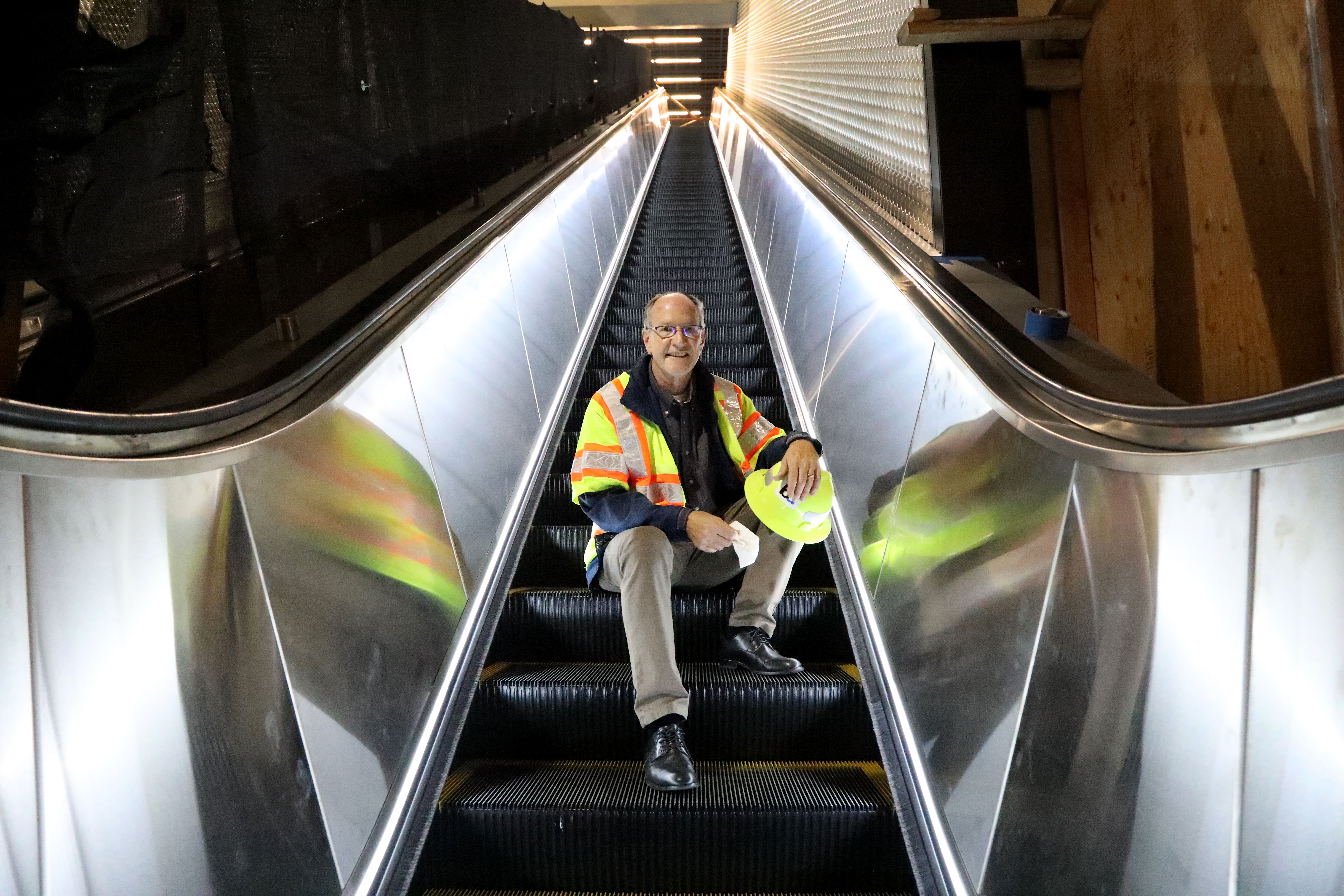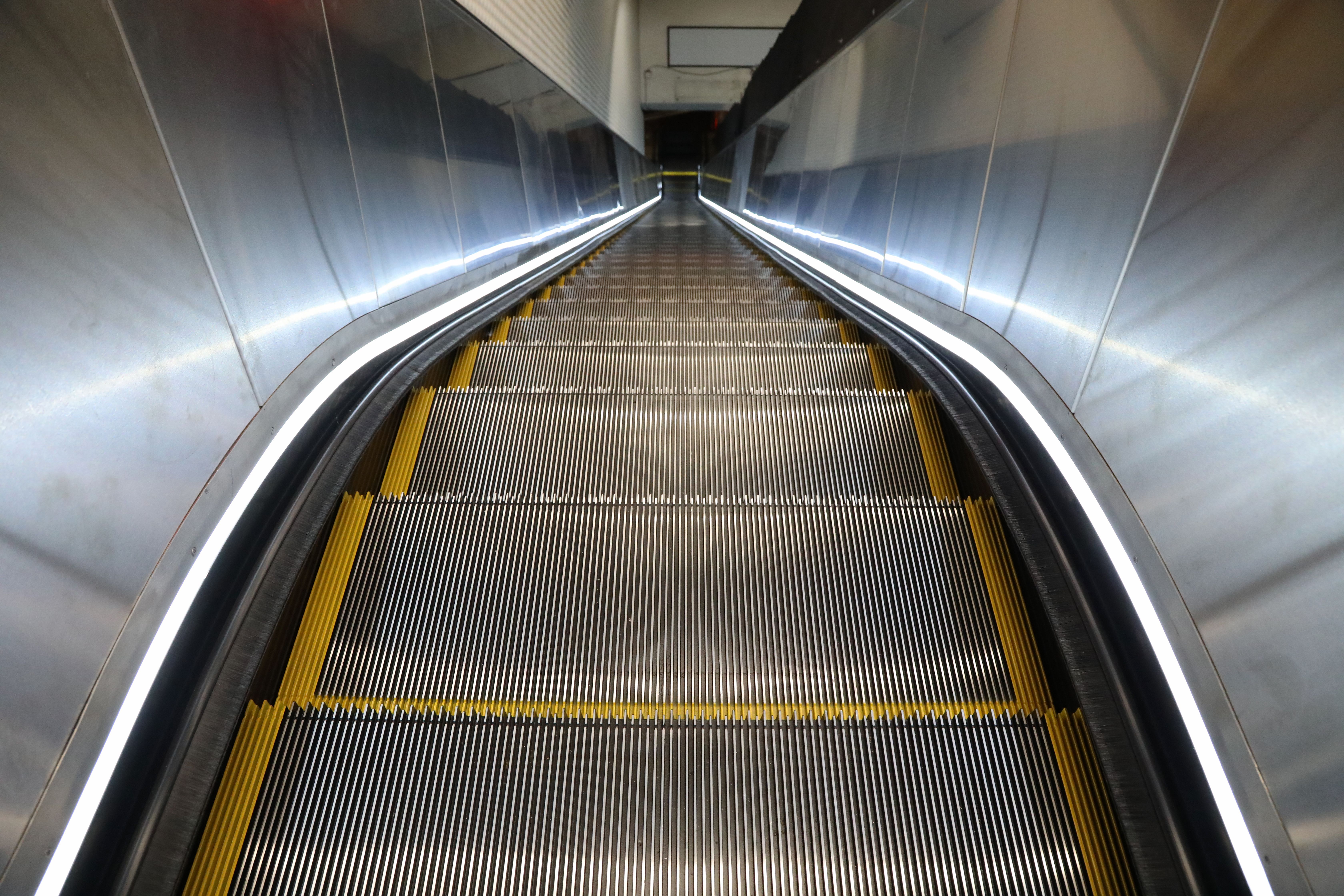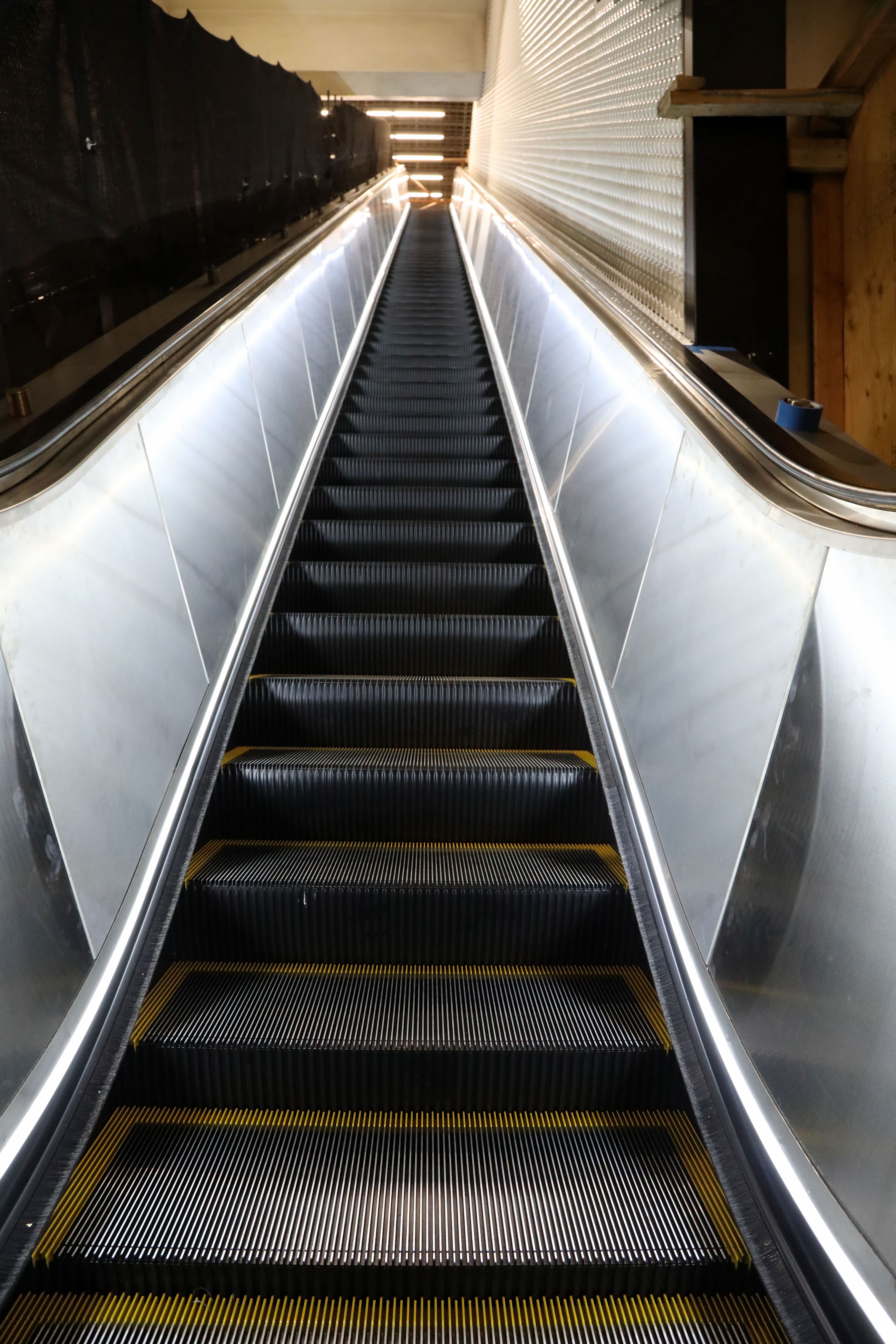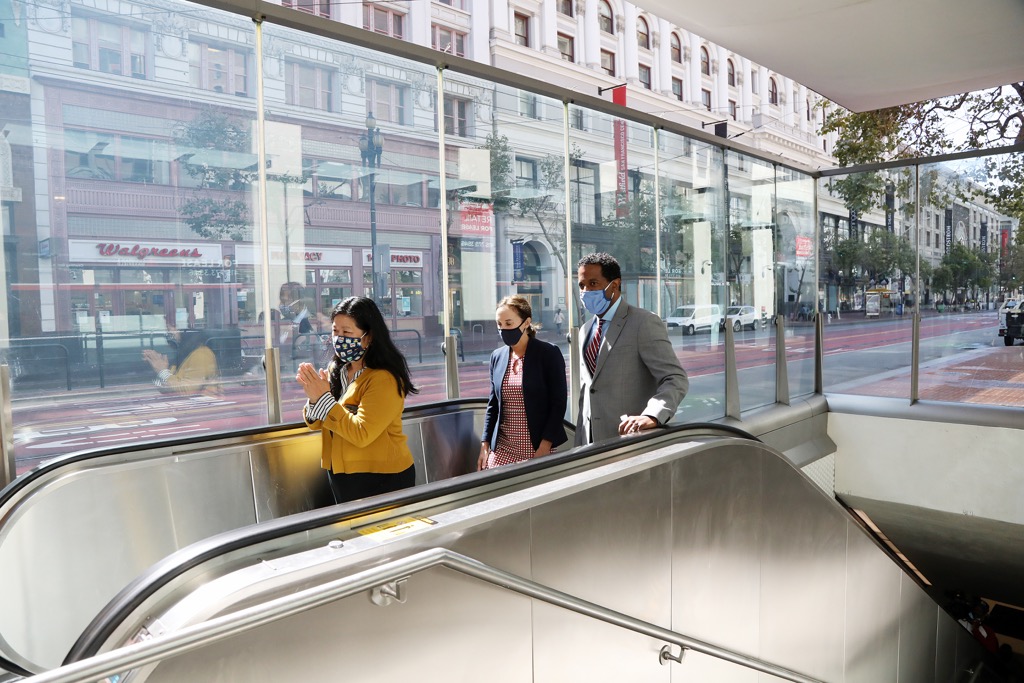Podcast: A new era arrives for escalators at BART

Transcript below:
HOST: “BART is making its largest investment in escalators in decades with a generational project, and soon riders will experience the difference, welcome to “Hidden Tracks Stories from BART.” On this edition of Hidden Tracks will dig deep into the Market Street Escalators Renovation Project. The new escalators are built especially for the challenges they'll face at BART and are a key part of the plan to revitalize the entrances to some of BART's busiest stations. Let's hear from Mark Dana who's the manager of the escalator project. He spoke while standing on one of the newest units at Powell Street Station, just before it was unveiled to the public.
Well, Mark, we're standing on one of the new escalators at the Powell Street Station, and it just, it jumps off the page in how it looks and the first thing I see, this is really exciting, is it literally glows at your feet.”
DANA: “It does, yeah, you're seeing the new LED skirt lighting that we've installed in these safety measure, and it's, it is very beautiful new finishes. They're great new additions to our system.”
HOST: “The riders are really going to notice the difference from day one with these and this is the largest investment that BART has ever made in its escalators. This is a hugely important project and you're in charge of this. Talk about the significance of that and what this is going to mean for our riders.”
DANA: “Right, well, we're just a small part of it. I've got a great team of construction managers, designers, the contractor is wonderful. But this is really a public, the public demanded new investment in the escalators, and they're funding it and we're delivering it. It's very exciting. We've got a lot of support from the directors who've implemented the plan and guidance from the general manager and on down. Everybody's really interested and It's something that we're all proud of. Again the public has funded these escalators so what the directors have done is they've asked us to find a way to make these escalators economical, get as many units as possible, which really works together because you know the economy of scale, getting more escalators built.”
HOST: “Part of the funding for this comes from Measure RR a voter approved bond measure back in 2016, $3.5 billion overall to rebuild the infrastructure at BART. So, it was voted on by the public by the BART district voters, and we're talking about replacing 41 escalators in the downtown San Francisco stations. That's just a huge undertaking and we really do have to give the old escalators their due because some of them have been in service for decades.”
DANA: “They have these are 40 or 50 years old and we're looking at escalators installed in the 70s. If you think about it automobiles, you don't see many on the road that are, that were built in the 70s and when you do they're in pretty rough condition and the ones that they do renovate or modify those are in somebody's garage they don't drive them every day where these escalators installed way back then, you know they're running 20 hours a day for 40-50 years. It's a testament to our maintenance department the managers and the technicians who are trained, skilled, and certified to work on our escalators. Keeping these things running for that length of time is really impressive and we're all grateful to them. But it's hard to do. These things are getting old, the equipment, each part is breaking down and you repair one part, one day, and the other parts get jealous I guess and the next day you might have to come back and repair something else. So, we're trying to do this to help the maintenance and engineering department with this, with their plan because they've got over 200 escalators, elevators to keep running.”

HOST: “Durability is hugely important. There's nothing I can think of more frustrating for a BART commuter to deal with their commute than get to a station and see that an escalator is broken down. That's a really frustrating experience for folks. Talk about the durability of these new units and how well they should hold up under some really heavy usage at our busiest stations.”
DANA: “Right, these are designed for heavy duty traffic loads. The materials and the equipment is all code compliant, meeting the newest codes for safety and performance. It's very important to us to have these operate and perform the way we've designed. In the contract, we have an equipment performance preservation program we call it, which requires the contractor to build these and then once we put them in service, they have to maintain them. So, when they're maintaining the escalators there's a better chance that the quality is going to be there because they don't want to have to put the extra effort in, they will, but the better they build them, the better the quality they provide the easier it is for them to maintain so that when we do turn them over to BART maintenance, we know that they're going to perform well.”
HOST: “Speaking with Mark Dana with the Market Street Escalators Renovation Project. We're actually standing on one of the first new units, it's going to be opened at the Powell Street Station. This is a podcast so people can see as we already mentioned, the lighting, just glows and brightens up the station. Talk about what the riders are going to see, how different that's going to be for folks and what they'll experience.”
DANA: “For one thing, the performance, we're trying to keep it 96% operational, out of a year we might have three days, where they're down hopefully not that many. But they're going to see new finishes, a new shiny escalator that isn't broken when they arrive in the morning. That's very important to us. I've been at the station sometimes when we have a couple of them down and for the people that are accessibility challenged and those that are trying to get to work when everybody's maybe a little late not because BART isn't on time but because they left home a little late. Everybody's trying to run up the stairs or get to work and it creates some safety hazards when you're trying to get past each other. Having a working escalator that can take you up comfortably and get some people off the stairs is really a benefit.”
HOST: “Yeah, they give peace of mind to, don't they, the fact that the lighting will stay on in an emergency so it really makes it safer in case of an extreme situation or perhaps a power outage or something like that for people to get to safety?”
DANA: “Right yeah the skirt lighting is mostly a safety, it looks great but it lights up the stair steps the treads and like you say when we lose power in the station if that ever happened this is on emergency power so we still have lighting so that people can safely egress the station and that's very important. We've got a lot of safety features in these escalators. The original structure of the escalator, the pit that it fits in is built to a certain size, we can't modify that, but we can modify the new equipment going in. We've tried to optimize the flat step entrances so, more level entry area so that people aren't immediately put onto an escalator that's rising and less opportunity to trip. We've got new controllers that monitor all of the new functions that the other equipment provides. The safety switches that will stop the escalator if a safety hazard is identified, and it notifies that controller and the controller will be able to tell what caused the fault so we can get the equipment repaired quicker.”

HOST: “And I think one of the things that's interesting about maintaining the current escalators, is that really has to be challenging because of their age. I would imagine there are challenges when it comes to not just dealing with old equipment but even finding replacement parts I would think would be difficult.”
DANA: “It is and what happens is we've got so many different types of existing heritage escalators. The stations were constructed, designed two stations at a time like Powell and Montgomery are the same basic design as each other and the same with Embarcadero and Civic Center their sister stations as well. But having different contracts that let these be built separately. We got different equipment so there's more parts to different types of units you know like the ones that we see adjacent when it was torn out was a Westinghouse and they've, and now it's going to be a Schindler, but we've got 41 Schindlers and we can provide the parts just for these. It's easier than say which type of unit which year is that unit that we're trying to repair. This will make it much more standardized much easier to provide the replacement parts and the familiarity with repairs.”
HOST: “And the contract sets requirements for performance and maintenance and keeping these units in working order.”
DANA: “Right we've got 96% performance requirements in this. It's very important to us to keep these things operating for the public. It's very important to our operations, we're in business to run trains and get people from one place to another. We've gotten a lot of great support from operations and transportation department. Station agents and the people that run these stations, trying to get us access to do our work and they're putting up with a little bit of inconvenience on each of these projects. We're not the only ones we've got to coordinate with, at this particular station the Powell Modernization Project is going on here, we’ve got the canopy project that will be going in soon. At the other stations, we've got substations that are being built, scissor stairs at Civic Center so there's a lot of projects we got to coordinate with. And again, being partners with the City on these projects they have their own projects that we need to coordinate with, the City is funding half of these station improvements. The escalators, all of the street entrances. Escalators that we're installing, the 23 that we're installing here Muni’s paying for half. It's very important that we coordinate all these projects and we work together on these.”
HOST: “These escalators are so visually striking but they're also kind of part of the package here because they're in conjunction with our canopy project, so we really are reshaping the look and design of the entrance points to our downtown San Francisco stations.”

DANA: “Oh we are. The canopy project, we built two already two pilot canopies to prove out the design, and they turned out very well and they're beautiful. But the code requires that we protect our investment of escalators at the street level from the weather. And so, the canopies are a glass walled structure that are meant to be transparent so you can see the storefronts in the sidewalk beyond the street. Not only so that the customers will know where they're going but also, we can see what activity might be happening in the sidewalk. It's a big safety thing as well as protecting the escalators themselves. We will have a roll up grill on the street side of the canopies to keep people from throwing garbage at night once the stations closed into the stairwell and escalators or sleeping in there. It's a safety thing for our station agents as well so when they come in to open the station in the morning they're not crawling over the debris or people sleeping to open the station. This can get very intimidating at times. The canopies themselves are a very beautiful design. It was, again, another effort between BART and the City of San Francisco and there was a competitive design process that we went through to pick out a winning concept and that got improved and the design finalized so that we could go out to bid with them and construct finally. That contract is also ongoing now. We're installing our system’s infrastructure throughout the stations to get ready for those canopy construction which will start in January, one at Powell Street and one at Montgomery.”
HOST: “And you mentioned the canopies will protect the street level escalators from the weather, how big of a factor has that been with the older escalators in terms of their maintenance issues, has whether been a factor?”
DANA: “When we take these escalators out of service for renovation, we do find a lot of corrosion related to rainfall, the wet conditions.”
HOST: “And it's just going to be more welcoming isn't it I mean it's a whole new look?”
DANA: “It is and it's sort of wayfinding, you’ll see a canopy and you'll know that's an entrance to BART and Muni stations. Another interesting part of this is we're installing art within the ceiling, so it's kind of a bas relief. We’re finding that's actually part of the difficulty of delivering these projects is getting the art so it will really show up nicely once we construct. Each of these stations will have its own set of art, it'll be four different artists were selected by a committee throughout our community. BART, Muni, local artists and businesses were involved in choosing the artists and then the art is being refined so that it will go into the ceilings, which are constructed with a fiber reinforced plastic. So, it'll be again a bas relief, sort of thing with some color to help make it pop, make it show up really well and I'm really excited to see how it turns out.”
HOST: “Speaking with Mark Dana with the Market Street Escalator Renovation Project and sustainability is a big goal at BART as well. Talk about how these escalators fit in with that.”
DANA: “Yes, it is very important. Our equipment includes regenerative drives. The braking process to keep the escalators under control, braking matter how much capacity, how many people are on the escalator. That energy is transmitted back into the system so we're not spending as much. We're saving energy with those. The lighting here has LED lighting so that's a very efficient system. And we're using the materials used in the escalator, it's lighter weight generally and just as strong as the original or stronger. Sustainability is a big part of this as well.”
HOST: “You spoke earlier about how many people rely on these escalators to get to their trains. It really is an impressive number and it's such a critical part of their commute on a regular basis. When you consider that, what does that mean to you and the work that you do?”
DANA: “Yeah, I'm very proud and excited to be working on these projects. I've got a great team and a good bunch of people that I'm working with, but I'm very proud to fulfill the wants of the public and the needs and BART's overall goal to get people to their destination on time and safely. Safety is a big part of this, but I felt very honored to be part of this and I work with a lot of great people. Our operations, transportation, community affairs, people that are helping us do our outreach to the public, all of the city organizations, the City itself, Better Market Street we coordinate with them on a monthly basis in all the other projects that are working with them. It’s a big project but there are a lot of big projects BART is performing right now and especially during this pandemic period we're all trying to do work at the same time, so it takes a lot of coordination. I'm just a small part of it but I'm happy to be involved in it and it's and about access and getting people on the trains moving through safely and getting to their destination.”
HOST: “Let's talk a little bit about the real-world experience of folks who ride the escalators. Escalator etiquette, you're an escalator expert, is that a thing? Am I supposed to stand on the right, is that the polite thing to do?”
DANA “I tend to think so but when people are in a hurry, they'll do whatever it takes to get there on time. But I think there's people that aren't, some people like to walk up the escalators and other people like to stand and wait but if they do, I think it's polite to stay to the side and let people pass you. Of course if you're carrying bags, there's just some things you just can't do and hopefully it's not a long ride and we're going to do our part not to have the escalator break down when you're on your way up.”
HOST: “I've heard that that's actually a bad thing for escalators that if people line up on one side and stand there, it creates a different sort of wear for the units is that true?”
DANA: “It's been said. There's still debate on that. You can understand that these are again heavy-duty escalators and we have a little less of that going on. I know that when you run an escalator in certain direction for a certain time and then try to reverse the escalator direction sometimes it does affect them. So, there's a lot of things that could, it's a very subtle difference, if any, but this new equipment monitors the speed of the handrail and the speed of the steps, and we check on things like that. That's all monitored and compared, but I think I'll stay out of that debate.”
HOST: “So the bottom line though for folks is whether I decide to stand to one side or walk up the escalators, these new units, they can handle it.”
DANA: “Yes I don't want the public to feel like they have to follow any of that to help save us. We're here for you and we're going to keep the escalators running. Walk or stand any way you need to get to work or home safely.”
HOST: “Thank you for listening to ‘Hidden Tracks: Stories from BART.’ You can listen to our podcasts on SoundCloud, iTunes, Google Play, Stitcher, and of course on our website, BART.gov/podcasts.”